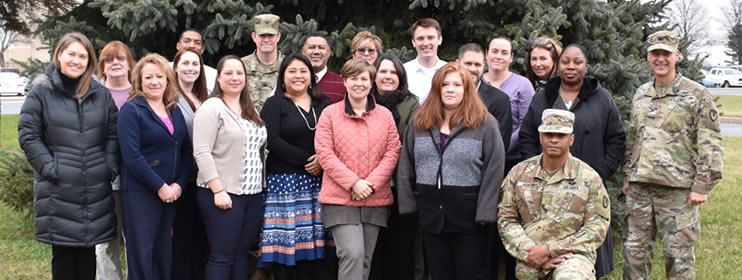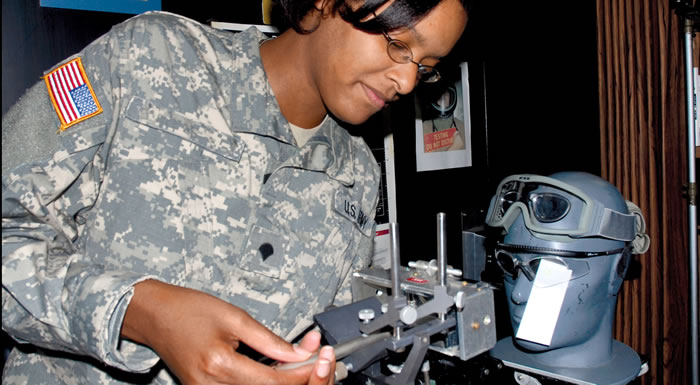USAMMDA Team Spotlight: Combat Trauma and Acute Rehabilitation Project Management Office

The mission of the Combat Trauma and Acute Rehabilitation Project Management Office of the U.S. Army Medical Materiel Development Activity is to field U.S. Food and Drug Administration-cleared or -approved medical devices, drugs and biologics to help support and sustain our nation's Warfighters. Comprised of Defense Acquisition Workforce professionals certified in fields that include program management, production quality and manufacturing, science and technology management, and testing and evaluation, the CTAR team brings to the organization a wide range of subject-matter expertise. The team leverages this knowledge to advance product development in areas such as hemorrhage detection and control, organ support, soft- and hard-tissue treatment and repair, and sensory organ damage.
In our continuing spotlight series, USAMMDA's public affairs team recently sat down with CTAR PMO project manager Christine Parker, who offered a candid look into the critical work of this engaging team. Parker's insightful perspective sheds much light on the types of cutting-edge medical products and devices that help to support the USAMMDA mission of developing and delivering important medical capabilities to protect, treat and sustain the health of Service Members throughout the world.
PAO: Please describe the type of work managed by the CTAR PMO.

CP: When a Warfighter is wounded, the injuries tend to be very complex, and commercial solutions may not address the severity of the injury, or be available in the austere location where the injury occurred. The CTAR PMO is responsible for delivering new medical solutions based on Warfighter-identified areas of need. Some of the gap areas include prolonged care, hemorrhage detection and control, wound care management to include burns, extremity injury repair of vascular, muscle and nerve. Currently, the team has two sensory acquisition programs: one is for hearing loss prevention, and the other for ocular stabilization and repair. The CTAR PMO looks at solutions related to rehabilitative and restorative treatment typically used in a fixed medical facility stateside. Overall, it is our responsibility to develop medical solutions throughout the entire continuum of care.
PAO: The CTAR PMO is one of the newest PMOs within USAMMDA, correct?
CP: "Combat Trauma and Acute Rehabilitation" may be a new name, but the work was previously performed by two PMOs that were merged. The "Medical Devices – Advanced Development" from the U.S. Army Medical Materiel Agency, and USAMMDA's "Tissue Injury and Regenerative Medicine" PMOs were combined in an effort to align resources and streamline efforts.
PAO: What would you say is the most exciting part of your job?
CP: What's not exciting? The mission, people, the projects are all exciting, as well as the ultimate goal of helping the wounded Service Member. Being able to provide medical solutions that are not currently available, and get these FDA-cleared, is life-changing. If we can save even one life, to me, that is the best mission in the world. Our Service Members dedicate their lives to making sure that we are safe here at home. I am honored to have a mission that helps develop medical solutions to increase the function of the wounded warfighter, reduce injury, and prevent death.
PAO: Can you please provide a bit more detail regarding the CTAR PMO's scope of work?
CP: Our focus is to deliver solutions that are not commercially available to users in the field. Our work is performed in accordance with the DoD Directive 5000.01 and DOD Instruction 5000.02. We need to be sure that we are developing solutions that address validated user needs and operational threats. In austere environments with limited resources, triaging the injured is not the same as going to the local hospital or clinic, which will have all of the proper clinical support and supplies. Depending on where the injury occurs, immediate evaluation, treatment and/or evacuation is not always possible. Traditional care that we are accustomed to in the U.S. becomes unavailable, and the scenario can quickly turn catastrophic. The DoD's enduring medical requirements must be FDA cleared/approved; as such, our team must be cognizant of the solution's approved indication for use, so that the right solution is fielded to the right user in the right place. A product for use by a combat medic verses a surgeon may not be the same due to user skill and/or user environment. The combination of supply availability, clinical ability and sustainability is all part of our acquisition strategy when taking on new projects.
An example of one of our identified gaps is hemorrhage; 90.9 percent of potentially survivable deaths that occur pre-medical treatment facility are associated with noncompressible hemorrhage. We must be able to both detect and control this severe bleeding as soon as possible. Usually, the medic is at the first line of defense. Depending on the injury, the bleeding may not be visible to the provider, increasing the potential of the patient going into shock and dying. The Hemorrhage Detection Program is focused on a diagnostic tool that will identify internal bleeding to allow for earlier treatment and possible prevention of shock altogether. Not only will this solution save lives, but it will enable providers to prioritize supplies and aid in evacuation decisions. The Noncompressible Hemorrhage Control Program seeks to find solutions that will control severe bleeding in places where a tourniquet cannot. In this instance, it will take a family of products to address this gap at all levels of care. The program is evaluating devices and biologics that can stabilize a patient until they can reach definitive surgical care.
PAO: Does the CTAR PMO have any new products on the horizon?
CP: Yes! This past year, we had a product called the CirQPOD™, which was FDA-cleared and will be coming up on a Milestone C review in fiscal year 2020. This particular device is one that is used on ventilated patients to help with the body's process of delivering blood to a capillary bed in its biological tissue. When a person is ventilated, having proper blood flow to all of the extremities is very important, and this device helps this happen.
Another success this past year is the Sprint Peripheral Nerve Stimulation system. It was developed through a Congressional special interest-funded effort, through the Joint Warfighter Medical Research Program, and recently received FDA 501(k) clearance. The 501(k) is a submission to show that our new device is as safe and effective, or "substantially equivalent," to another FDA-approved device already on the market. The Sprint system is an alternative therapy for pain management, versus the typical pain medications that are usually offered. This is a drug-free, minimally invasive therapy that aims to minimize the need for opioids.
Along with these new products, another recent success is a steam sterilizer, developed through an industry partner, which the Army is now fielding in its sets. We also have the Burn Resuscitation Decision Support Small-Mobile device, or Burn Navigator. This device helps inform the provider how much fluid the patient should receive. Over-resuscitation of burn patients can lead to abdominal compartment syndrome, compartment syndrome of the limbs, and pulmonary edema, leading to tracheostomy that might not otherwise be necessary. These are just two of the successes fielded by the team.
PAO: What are your thoughts on the CTAR PMO, and the work you and your team are doing?
CP: For me, personally, I never thought in a million years this is the work that I would be doing. I'm proud to be doing this work and humbled to know that we play a role in making sure that our Service Members have exactly what they need. If anything does happen to them as a result of their service to our country, we ensure that they have the best possible care to lead a fulfilling life. We really have the best team – and it's a very unique team – from biologists to doctors, to biomedical engineers and program managers. This special team of people is really what keeps me going. They work very hard and are very dedicated, and they take the acquisition process very seriously. They make sure that our partnering companies are fulfilling the needs of what we've asked them to do. Ultimately, they make sure that we have safe and effective products that not only can be fielded to those who need it, but that these solutions are ruggedized and suitable for the austere environment. And that is a huge part of the acquisition process – it's one thing to build something and have it become a new item in a Warfighter's pack, but it's another thing for the person to be able to use it properly, maintain it, and keep it working.
PAO: Can you please describe the CTAR PMO's role in product development?
CP: Our team of acquisition-certified program managers develop the contracts and agreements to ensure that all of the requirements are identified, and that the developmental effort will meet environmental and operational standards. Prior to placing a new item in our medical sets, we perform rigorous testing in the lab and in an operationally representative environment to ensure these FDA-cleared devices are not only effective but suitable for use in austere locations. Our team relies on our medical users, partners, and end-users to ensure new products will be reliably fielded, maintainable and supportable.
PAO: Do you have any final thoughts that you would like to share?
CP: There are many layers of expertise to accomplish what we do within the CTAR PMO, and our dedicated team helps us to field relevant medical solutions to protect, treat, and rehabilitate our Service Members. It's our top priority. The team is honored and proud to support the medical needs of the military.
To view the USAMMDA PAO interview with Christine Parker, click on the following link: CTAR Interview with Christine Parker













